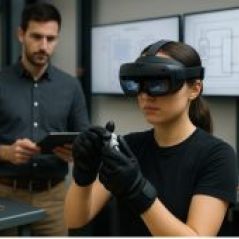
Britain’s biggest electrical apprenticeship providers say virtual reality lessons are cutting dropout rates and speeding skills growth, an early answer to the looming shortage of qualified electricians.
Mr Mannu a director at Elec Training said “we have been piloting the use of VR within in our practical and theory training for some time now, I feel as its getting more important to be able to give students what they need in regards to their electrician course”
The most urgent need sits in the numbers, the Construction Industry Training Board projects the UK will require roughly 14,500 new electricians every year to 2028, yet colleges produced only 9,600 in 2022.
Why tutors are turning to headsets
Learners now complete basic lock-out, tag-out, and single phase fault diagnosis inside a simulated switch room before touching live boards. The new unit cut incident reports to zero and trimmed classroom time for the same material from three hours to ninety minutes.
Benchmark statistic – “Pass rates on first attempt climbed 42 percent after the VR rollout,” said Martyn Williams, operations director at a national training school. He adds that scrap copper, conduit offcuts, and broken accessories once cost the hub about £30,000 a year, the headset program reduced that bill by two thirds.
Headset supplier ActiveLens, a Sheffield start-up, builds the scenarios with game-engine software. Each rig pairs tracked hand tools with haptic gloves so users feel resistance when they tighten a gland or torque a busbar bolt. The software records every move, giving tutors clear scores on sequence and safety compliance.
Broader rollout across the sector
East Coast College in Lowestoft will install six identical pods this autumn. The unit plans to add renewable energy tasks, including string inverter wiring and domestic battery storage commissioning, areas flagged as skill gaps in the National Grid’s 2030 workforce report.
At the Institute of Engineering and Technology’s Stevenage lab, developers create fresh modules inside a week, allowing syllabuses to keep pace with market demand. A recent upload covers PV string testing and EV charging point inspection, reflecting rising callouts in residential work.
Not everyone is convinced. Some warn that a headset cannot teach the weight of steel wire armoured cable or the finesse of dressing conductors in a consumer unit.
City & Guilds examiners agree, they will still require a minimum number of bench hours with real gear for Level 3 diplomas and the AM2 competence test.
Small contractors raise cost questions. Kevin Patel, who runs a five-person firm in Leicester, says, “A single rig is ten grand, tuition fees will go up if providers pass that on.” Some companies have countered that, as per-student material spending has already fallen, creating headroom for investment.
Government interest and new funding
The Department for Energy Security and Net Zero will open a £12 million equipment grant in October. Bids must show that at least thirty percent of electrical coursework will use immersive tech by 2027. Officials argue that faster, safer training aligns with national targets for heat pump installs and EV charger rollouts.
Global context
Research firm Market Research Future values the world VR training market at $22.6 billion in 2025, rising to $82.9 billion by 2034, a fifteen percent annual gain. Electrical and mechanical trades make up the fastest-growing slice. UK colleges see an opportunity to lead and export curricula, according to the Association of Employment and Learning Providers.
“I fixed my first breaker in VR on Tuesday, next week I try it on the real board,” said first-year apprentice Ben Ogden, wiping virtual dust from his headset, “honestly, this kit makes learning less scary and a lot quicker.”













